

What is Consuming Hydrogen and Acetylene on Titan? What is Consuming Hydrogen and Acetylene on Titan?
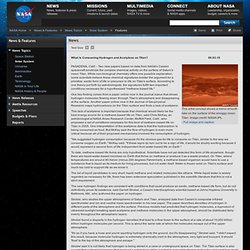
PASADENA, Calif. - Two new papers based on data from NASA's Cassini spacecraft scrutinize the complex chemical activity on the surface of Saturn's moon Titan. While non-biological chemistry offers one possible explanation, some scientists believe these chemical signatures bolster the argument for a primitive, exotic form of life or precursor to life on Titan's surface. According to one theory put forth by astrobiologists, the signatures fulfill two important conditions necessary for a hypothesized "methane-based life. " One key finding comes from a paper online now in the journal Icarus that shows hydrogen molecules flowing down through Titan's atmosphere and disappearing at the surface. Another paper online now in the Journal of Geophysical Research maps hydrocarbons on the Titan surface and finds a lack of acetylene. To date, methane-based life forms are only hypothetical. For more information about the Cassini-Huygens mission visit and.
Titan: Nasa scientists discover evidence 'that alien life exists. The first paper, in the journal Icarus, shows that hydrogen gas flowing throughout the planet’s atmosphere disappeared at the surface.

This suggested that alien forms could in fact breathe. The second paper, in the Journal of Geophysical Research, concluded that there was lack of the chemical on the surface. Scientists were then led to believe it had been possibly consumed by life. Researchers had expected sunlight interacting with chemicals in the atmosphere to produce acetylene gas. But the Cassini probe did not detect any such gas. Chris McKay, an astrobiologist at Nasa Ames Research Centre, at Moffett Field, California who led the research, said: “We suggested hydrogen consumption because it's the obvious gas for life to consume on Titan, similar to the way we consume oxygen on Earth. "If these signs do turn out to be a sign of life, it would be doubly exciting because it would represent a second form of life independent from water-based life on Earth.”
Life on Titan? Will Huygens land or splashdown on Titan?
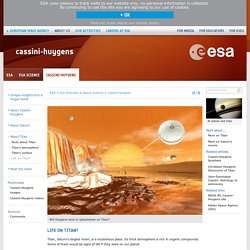
Life on Titan? Titan, Saturn's largest moon, is a mysterious place. Its thick atmosphere is rich in organic compounds. Scientists excited by signs of life on Saturn's moon. Signs of life on Saturn's moon Evidence found by NASA Join us over on Facebook | Twitter This image supplied by NASA sparked excitement from scientists who say it shows evidence of life Source: NewsCore EVIDENCE of life has been discovered on Saturn's biggest moon, Titan.
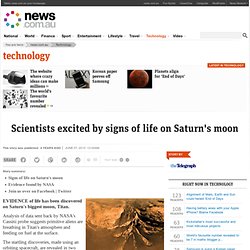
Analysis of data sent back by NASA's Cassini probe suggests primitive aliens are breathing in Titan's atmosphere and feeding on fuel at the surface. The startling discoveries, made using an orbiting spacecraft, are revealed in two separate reports. Organic chemicals had already been detected on Titan but the liquid is methane, not water, and scientists expect life there to be methane-based.
The first paper said hydrogen gas flowing down through Titan's atmosphere disappears at the surface, suggesting it could be being breathed by alien bugs. The other paper reports there is a lack of a certain chemical on the surface, leading scientists to believe it may be being consumed by life. Cassini Spots Potential Ice Volcano On Saturn Moon. RELEASE : 10-335 Cassini Spots Potential Ice Volcano On Saturn Moon WASHINGTON -- NASA's Cassini spacecraft has found possible ice volcanoes on Saturn's moon Titan that are similar in shape to those on Earth that spew molten rock.

Topography and surface composition data have enabled scientists to make the best case yet in the outer solar system for an Earth-like volcano landform that erupts in ice. The results were presented today at the American Geophysical Union meeting in San Francisco. "When we look at our new 3-D map of Sotra Facula on Titan, we are struck by its resemblance to volcanoes like Mt. Etna in Italy, Laki in Iceland and even some small volcanic cones and flows near my hometown of Flagstaff," said Randolph Kirk, who led the 3-D mapping work, and is a Cassini radar team member and geophysicist at the U.S. Geological Survey (USGS) Astrogeology Science Center in Flagstaff, Ariz.
Kirk and colleagues analyzed new Cassini radar images. Cassini spots potential ice volcanoes on Saturn's moon Titan. NASA's Cassini spacecraft has found possible ice volcanoes on Saturn's moon Titan that are similar in shape to those on Earth that spew molten rock.
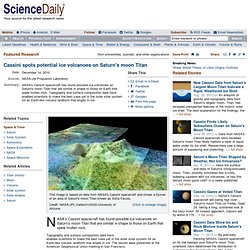
Topography and surface composition data have enabled scientists to make the best case yet in the outer solar system for an Earth-like volcano landform that erupts in ice. The results were presented at the American Geophysical Union meeting in San Francisco. "When we look at our new 3-D map of Sotra Facula on Titan, we are struck by its resemblance to volcanoes like Mt. Etna in Italy, Laki in Iceland and even some small volcanic cones and flows near my hometown of Flagstaff," said Randolph Kirk, who led the 3-D mapping work, and is a Cassini radar team member and geophysicist at the U.S. Geological Survey (USGS) Astrogeology Science Center in Flagstaff, Ariz. Scientists have been debating for years whether ice volcanoes, also called cryovolcanoes, exist on ice-rich moons, and if they do, what their characteristics are.
Titan (moon) Titan (or Saturn VI) is the largest moon of Saturn.
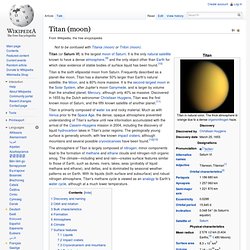
It is the only natural satellite known to have a dense atmosphere,[9] and the only object other than Earth for which clear evidence of stable bodies of surface liquid has been found.[10] Titan is primarily composed of water ice and rocky material. Much as with Venus prior to the Space Age, the dense, opaque atmosphere prevented understanding of Titan's surface until new information accumulated with the arrival of the Cassini–Huygens mission in 2004, including the discovery of liquid hydrocarbon lakes in Titan's polar regions. The geologically young surface is generally smooth, with few known impact craters, although mountains and several possible cryovolcanoes have been found.[12][13] The atmosphere of Titan is largely composed of nitrogen; minor components lead to the formation of methane and ethane clouds and nitrogen-rich organic smog. Titan was discovered on March 25, 1655, by the Dutch astronomer Christiaan Huygens.